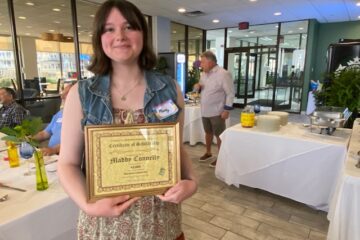 VENTNOR – The Planning Board spent nearly two hours Monday July 30 listening to concerns from St. Leonard’s Tract residents before it decides if it will rezone three undeveloped lots along the boardwalk.
VENTNOR – The Planning Board spent nearly two hours Monday July 30 listening to concerns from St. Leonard’s Tract residents before it decides if it will rezone three undeveloped lots along the boardwalk.
The board took their comments, which were mostly against making any changes to the R-1 zone, under advisement, but took no action. Instead, board members will consider their concerns over the next two weeks and review the city’s Master Plan before discussing the issue at its Aug. 27 meeting, chairman Jay Cooke said.
“Now we are faced with a situation to find the best way to zone this property in a way that benefits the entire city,” said Cooke, who called the proposed change “de minimus.”
“We are in partnership with you,” he said inviting comments.
Commissioner Lance Landgraf, a professional planner and the Board of Commissioners representative on the Planning Board, said the lots between Dorset and Derby avenues, which have been sitting idle for 13 years, are not in conformance with the rest of the properties in the zoning district and should be changed to spur development. He said they were “spot zoned” during a 2003 subdivision application to be larger than the rest and should be reconfigured to comply with other lots in the area.
The boardwalk area abuts the prestigious St. Leonard’s Tract, which includes large homes on 50- by 125-foot lots, from Atlantic Avenue to Inside Thorofare and from Surrey to Cambridge avenues. Most of the homes were built in the 1920s and have housed such notables as Governor Walter Edge and John Wanamaker.
The city introduced and adopted Ordinance 2018-023 but pulled language about rezoning the lots from the May 24 agenda. The city scheduled the planning board meeting to solicit input from the public.
Language in the ordinance reduced the minimum lot size for oceanfront lots to 7,500 square feet from 10,000 square feet with a minimum lot width of 60 feet for interior lots and 8,125 square feet with a minimum lot width of 65 feet for corner lots facing the street.
Resident Todd Miller presented his analysis of all properties along the 43-block-long boardwalk noting that of the 68 lots that are zoned residential, 54 of them have between 60 and 80 feet of boardwalk frontage, and 10, including the three in question, are 80 feet or larger. Only four are less than 60 feet wide, he said.
Miller also noted that four oceanfront lots with boardwalk frontage have sold in the last year and two of them currently have homes under construction.
“There doesn’t seem to be lack of desire to build on the oceanfront in Ventnor,” he said.
It was the price of those lots that made them sell, he said.
One lot sold for $995,000 and another sold for $1,050,000, he said.
Reducing the lot size requirement would encourage investors to demolish homes on larger lots that are part of the history of Ventnor, he said.
“That is the downside to making these smaller oceanfront lots. We may be encouraging the destruction of the history that makes our town so wonderful,” he said, calling for the board to keep the status quo.
Resident and builder John Irons said the lots that have sat idle for so many years are overpriced. One is on the market for $2.4 million and the other $3.2 million.
That and Ventnor’s high tax rate are the reasons those lots have not sold, he said.
Michael Touhy, who purchased the 85-foot lot on Dorset Avenue, said he did so because he wanted a big lot to be separated from his neighbors.
“If I wanted a 50-foot lot, I could have bought anywhere in Ventnor,” he said. “We bought expressly because of the zoning it had.”
Resident Craig Anmuth said 80-foot lots are “the exact correct number.”
“This area of St. Leonard’s Tract is the jewel of all of Ventnor. This is where the history of Ventnor resides. It is where every home of any key architectural significance lives,” he said. “If you lessen the requirements for building, you’re encouraging demolition of these beautiful old homes that were built by hand.”
Developers just want to maximize lot coverage and build as many homes as they can, he said.
He advocated instead to create an historic district of sorts and create tax incentives to historically renovate them.
“Save the history of Ventnor and at the end of the day it benefits every resident,” he said. “It’s what we showcase to the people who walk up and down the boardwalk every day.”
Resident Ken Zucker said he chose to live in Ventnor for its diversity of homes and people and the uniqueness of his home.
“We are temporary custodians of this area. Once we make a change to change the character of that area, it is changed it forever,” he said. “It should be preserved the way it is.”
St. Leonard’s Tract Homeowners Association President Anne Corrigan advocated to historically preserve without obtaining any official state or federal historic designation, which can open a Pandora’s box, she said.
“Keep the are historic without signing on to make people do things that they don’t want to do,” she said.
Resident Michael Bluestein said the board appears to be considering rezoning to generate tax revenue, however, Cooke assured the public that no measures are being taken to assist any sale.
Bluestein said if the city reduces lot size requirements it will lessen the value of homes in the surrounding area.
Residents also said the squeezing in another home would exacerbate traffic congestion in the area.
Architect Arthur W. Ponzio also surveyed the R-1 district and said If the board decides to rezone it would not change most of the properties in the zone.
The maximum number of lots, even if the owners collaborated on a subdivision, would be four lots, he said, which is how the area was originally designed.


